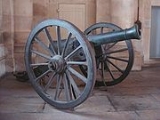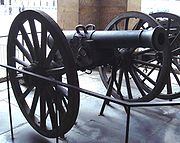
Canon obusier de 12
Encyclopedia
The Canon obusier de 12 (French:"Canon obusier de campagne de 12 cm, modèle 1853", USA: 12-pounder Napoleon), also known as the "Canon de l’Empereur" was a type of canon-obusier (literally "Shell-gun cannon", "gun-howitzer
") developed by France in 1853. Its performance and versatility (it was able to fire either ball
, shell
, canister
or grapeshot
) allowed it to replace all the previous field guns, especially the Canon de 8 and the Canon de 12 as well as the two howitzers of the Valée system
.
The cannon owes its alias to French
president and emperor Napoleon III
.
 The "canon obusier" was a smoothbore cannon using either shells, balls or canisters, and was therefore a vast improvement over previous cannon firing metal balls, such as the Gribeauval system
The "canon obusier" was a smoothbore cannon using either shells, balls or canisters, and was therefore a vast improvement over previous cannon firing metal balls, such as the Gribeauval system
. Although the "Canon obusier de 12" is commonly described as a 12-pounder
in English, the "12" in the cannon's designation actually represents the caliber (12 cm). The new weapon "revolutionized field artillery. The Napoleon was light enough to be moved rapidly on the battlefield by horses, heavy enough to destroy field fortifications almost a mile away, and versatile enough to fire solid shot, shell, spherical case, and canister." The French Army
introduced the "canon obusier de 12" in 1853.
. Over 1,100 such Napoleons were manufactured by the North, and 600 by the South. At Gettysburg
, 142 out of 360 Federal guns (36%) were Napoleons.
The "12-pounder Napoleon" was widely admired because of its safety, reliability, and killing power, especially at close range. It was the last cast bronze
gun used by an American army. The Federal
version of the Napoleon can be recognized by the flared front end of the barrel, called the muzzle swell. Confederate Napoleons were produced in at least six variations, most of which had straight muzzles, but at least eight cataloged survivors of 133 identified have muzzle swells.
 The smoothbore
The smoothbore
"canon obusier" was soon superseded by rifled cannons, which had much more accuracy and range, with the developments of Antoine Treuille de Beaulieu
and the introduction of the La Hitte system
in 1858.
Napoleon III had his existing guns, such as the Canon obusier de 12, rifled to accommodate the La Hitte system system. Such guns remained in use until 1870.
Howitzer
A howitzer is a type of artillery piece characterized by a relatively short barrel and the use of comparatively small propellant charges to propel projectiles at relatively high trajectories, with a steep angle of descent...
") developed by France in 1853. Its performance and versatility (it was able to fire either ball
Round shot
Round shot is a solid projectile without explosive charge, fired from a cannon. As the name implies, round shot is spherical; its diameter is slightly less than the bore of the gun it is fired from.Round shot was made in early times from dressed stone, but by the 17th century, from iron...
, shell
Shell (projectile)
A shell is a payload-carrying projectile, which, as opposed to shot, contains an explosive or other filling, though modern usage sometimes includes large solid projectiles properly termed shot . Solid shot may contain a pyrotechnic compound if a tracer or spotting charge is used...
, canister
Canister shot
Canister shot is a kind of anti-personnel ammunition used in cannons. It was similar to the naval grapeshot, but fired smaller and more numerous balls, which did not have to punch through the wooden hull of a ship...
or grapeshot
Grapeshot
In artillery, a grapeshot is a type of shot that is not a one solid element, but a mass of small metal balls or slugs packed tightly into a canvas bag. It was used both in land and naval warfare. When assembled, the balls resembled a cluster of grapes, hence the name...
) allowed it to replace all the previous field guns, especially the Canon de 8 and the Canon de 12 as well as the two howitzers of the Valée system
Valée system
The Valée system was an artillery system developed between 1825 and 1831 by the French artillery officer Sylvain Charles Valée, and officially adopted by the French Army from 1828.-Specifications:...
.
The cannon owes its alias to French
France
The French Republic , The French Republic , The French Republic , (commonly known as France , is a unitary semi-presidential republic in Western Europe with several overseas territories and islands located on other continents and in the Indian, Pacific, and Atlantic oceans. Metropolitan France...
president and emperor Napoleon III
Napoleon III of France
Louis-Napoléon Bonaparte was the President of the French Second Republic and as Napoleon III, the ruler of the Second French Empire. He was the nephew and heir of Napoleon I, christened as Charles Louis Napoléon Bonaparte...
.
Characteristics

Gribeauval system
The Gribeauval system was an artillery system introduced by Lieutenant General Jean Baptiste Vaquette de Gribeauval during the 18th century. This system revolutionized French cannon, with a new production system that allowed lighter, more uniform guns without sacrificing range. The Gribeauval...
. Although the "Canon obusier de 12" is commonly described as a 12-pounder
Twelve-pound cannon
The twelve-pound cannon is a cannon that fires twelve-pound projectiles from its barrel, as well as grapeshot, chainshot, shrapnel, and later shells and canister shot. It was first used during the Tudor period and reached its production top in the Napoleonic wars...
in English, the "12" in the cannon's designation actually represents the caliber (12 cm). The new weapon "revolutionized field artillery. The Napoleon was light enough to be moved rapidly on the battlefield by horses, heavy enough to destroy field fortifications almost a mile away, and versatile enough to fire solid shot, shell, spherical case, and canister." The French Army
French Army
The French Army, officially the Armée de Terre , is the land-based and largest component of the French Armed Forces.As of 2010, the army employs 123,100 regulars, 18,350 part-time reservists and 7,700 Legionnaires. All soldiers are professionals, following the suspension of conscription, voted in...
introduced the "canon obusier de 12" in 1853.
American career
This type of "canon abusier", commonly called in English the "12-pounder Napoleon Model 1857", was the primary cannon used in the American Civil WarAmerican Civil War
The American Civil War was a civil war fought in the United States of America. In response to the election of Abraham Lincoln as President of the United States, 11 southern slave states declared their secession from the United States and formed the Confederate States of America ; the other 25...
. Over 1,100 such Napoleons were manufactured by the North, and 600 by the South. At Gettysburg
Battle of Gettysburg
The Battle of Gettysburg , was fought July 1–3, 1863, in and around the town of Gettysburg, Pennsylvania. The battle with the largest number of casualties in the American Civil War, it is often described as the war's turning point. Union Maj. Gen. George Gordon Meade's Army of the Potomac...
, 142 out of 360 Federal guns (36%) were Napoleons.
The "12-pounder Napoleon" was widely admired because of its safety, reliability, and killing power, especially at close range. It was the last cast bronze
Bronze
Bronze is a metal alloy consisting primarily of copper, usually with tin as the main additive. It is hard and brittle, and it was particularly significant in antiquity, so much so that the Bronze Age was named after the metal...
gun used by an American army. The Federal
Union Army
The Union Army was the land force that fought for the Union during the American Civil War. It was also known as the Federal Army, the U.S. Army, the Northern Army and the National Army...
version of the Napoleon can be recognized by the flared front end of the barrel, called the muzzle swell. Confederate Napoleons were produced in at least six variations, most of which had straight muzzles, but at least eight cataloged survivors of 133 identified have muzzle swells.
Succession

Smoothbore
A smoothbore weapon is one which has a barrel without rifling. Smoothbores range from handheld firearms to powerful tank guns and large artillery mortars.-History of firearms and rifling:...
"canon obusier" was soon superseded by rifled cannons, which had much more accuracy and range, with the developments of Antoine Treuille de Beaulieu
Antoine Treuille de Beaulieu
Antoine Hector Thésée Treuille de Beaulieu was a French General of the 19th century, who developed the concept of rifled guns in the French Army. He studied the subject of rifling between 1840 and 1852. Following a request by Napoleon III in 1854 to develop such a weapon, the de Beaulieu system...
and the introduction of the La Hitte system
La Hitte system
The La Hitte system , named after the French general Ducos, Count de La Hitte, was an artillery system designed in March 1858 to implement rifled muzzle-loading guns in the French Army.-Conception:...
in 1858.
Napoleon III had his existing guns, such as the Canon obusier de 12, rifled to accommodate the La Hitte system system. Such guns remained in use until 1870.
See also
- French weapons in the American Civil WarFrench weapons in the American Civil WarFrench weapons in the American Civil War had a key role in the conflict and encompassed most of the sectors of weaponry of the American Civil War , from artillery to firearms, submarines and ironclad warships. The effect of French weapons was especially significant in field artillery and infantry...
- Field artillery in the American Civil WarField artillery in the American Civil WarField artillery in the American Civil War refers to the important artillery weapons, equipment, and practices used by the Artillery branch to support the infantry and cavalry forces in the field. It does not include siege artillery, use of artillery in fixed fortifications, or coastal or naval...
- licorneLicorneLicorne was an 18th and 19th century Russian cannon, a type of muzzle-loading howitzer, devised in 1757 by M.W. Danilov and S.A...
- Twelve-pound cannonTwelve-pound cannonThe twelve-pound cannon is a cannon that fires twelve-pound projectiles from its barrel, as well as grapeshot, chainshot, shrapnel, and later shells and canister shot. It was first used during the Tudor period and reached its production top in the Napoleonic wars...

